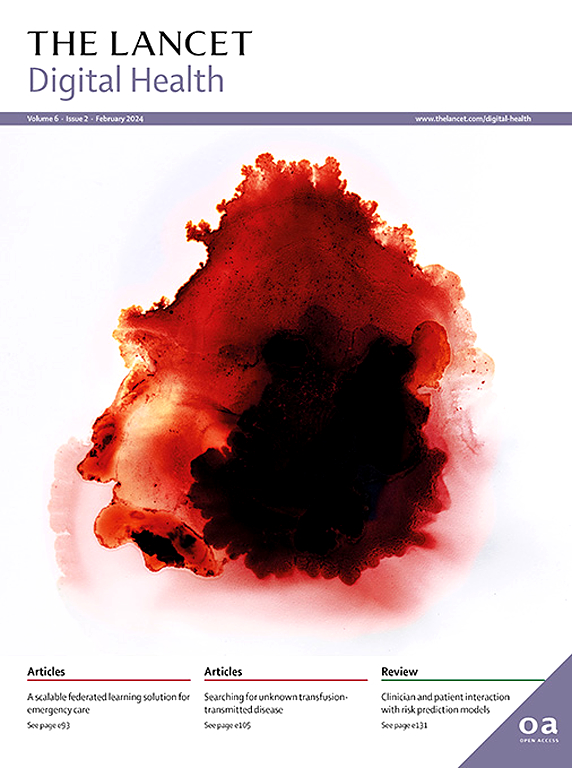Diagnostic accuracy of a machine learning algorithm using point-of-care high-sensitivity cardiac troponin I for rapid rule-out of myocardial infarction: a retrospective study
IF 23.8
1区 医学
Q1 MEDICAL INFORMATICS
引用次数: 0
Abstract
Background
Point-of-care (POC) high-sensitivity cardiac troponin (hs-cTn) assays have been shown to provide similar analytical precision despite substantially shorter turnaround times compared with laboratory-based hs-cTn assays. We applied the previously developed machine learning based personalised Artificial Intelligence in Suspected Myocardial Infarction Study (ARTEMIS) algorithm, which can predict the individual probability of myocardial infarction, with a single POC hs-cTn measurement, and compared its diagnostic performance with standard-of-care pathways for rapid rule-out of myocardial infarction.
Methods
We retrospectively analysed pooled data from consecutive patients of two prospective observational cohorts in geographically distinct regions (the Safe Emergency Department Discharge Rate cohort from the USA and the Suspected Acute Myocardial Infarction in Emergency cohort from Australia) who presented to the emergency department with suspected myocardial infarction. Patients with ST-segment elevation myocardial infarction were excluded. Safety and efficacy of direct rule-out of myocardial infarction by the ARTEMIS algorithm (at a pre-specified probability threshold of <0·5%) were compared with the European Society of Cardiology (ESC)-recommended and the American College of Cardiology (ACC)-recommended 0 h pathways using a single POC high-sensitivity cardiac troponin I (hs-cTnI) measurement (Siemens Atellica VTLi as investigational assay). The primary diagnostic outcome was an adjudicated index diagnosis of type 1 or type 2 myocardial infarction according to the Fourth Universal Definition of Myocardial Infarction. The safety outcome was a composite of incident myocardial infarction and cardiovascular death (follow-up events) at 30 days. Additional analyses were performed for type I myocardial infarction only (secondary diagnostic outcome), and for each cohort separately. Subgroup analyses were performed for age (<65 years vs ≥65 years), sex, symptom onset (≤3 h vs >3 h), estimated glomerular filtration rate (<60 mL/min per 1·73 m2 vs ≥60 mL/min per 1·73 m2), and absence or presence of arterial hypertension, diabetes, a history of coronary artery disease, myocardial infarction, or heart failure, smoking, and ischaemic electrocardiogram signs.
Findings
Among 2560 patients (1075 [42%] women, median age 58 years [IQR 48·0–69·0]), prevalence of myocardial infarction was 6·5% (166/2560). The ARTEMIS-POC algorithm classified 899 patients (35·1%) as suitable for rapid rule-out with a negative predictive value of 99·96% (95% CI 99·64–99·96) and a sensitivity of 99·68% (97·21–99·70). For type I myocardial infarction only, negative predictive value and sensitivity were both 100%. Proportions of missed index myocardial infarction (0·05% [0·04–0·42]) and follow-up events at 30 days (0·07% [95% CI 0·06–0·59]) were low. While maintaining high safety, the ARTEMIS-POC algorithm identified more than twice as many patients as eligible for direct rule-out compared with guideline-recommended ESC 0 h (15·2%) and ACC 0 h (13·8%) pathways. Superior efficacy persisted across all clinically relevant subgroups.
Interpretation
The patient-tailored, medical decision support ARTEMIS-POC algorithm applied with a single POC hs-cTnI measurement allows for very rapid, safe, and more efficient direct rule-out of myocardial infarction than guideline-recommended pathways. It has the potential to expedite the safe discharge of low-risk patients from the emergency department including early presenters with symptom onset less than 3 h at the time of admission and might open new opportunities for the triage of patients with suspected myocardial infarction even in ambulatory, preclinical, or geographically isolated care settings.
Funding
The German Center for Cardiovascular Research (DZHK).
使用床旁高敏心肌肌钙蛋白 I 快速排除心肌梗死的机器学习算法的诊断准确性:一项回顾性研究。
背景:已有研究表明,与基于实验室的高敏心肌肌钙蛋白(hs-cTn)检测法相比,床旁(POC)高敏心肌肌钙蛋白(hs-cTn)检测法尽管周转时间大大缩短,但却能提供相似的分析精度。我们应用了之前开发的基于机器学习的个性化人工智能疑似心肌梗死研究(ARTEMIS)算法,该算法可通过单次 POC hs-cTn 测量预测心肌梗死的个体概率,并将其诊断性能与快速排除心肌梗死的标准护理路径进行了比较:我们回顾性分析了地理位置不同地区的两个前瞻性观察队列(美国的安全急诊科出院率队列和澳大利亚的急诊科疑似急性心肌梗死队列)中因疑似心肌梗死而到急诊科就诊的连续患者的汇总数据。ST段抬高型心肌梗死患者被排除在外。通过 ARTEMIS 算法(预先指定的概率阈值为 3 小时)、估计肾小球滤过率(2vs ≥60 mL/min 每 1-73 m2)、无或有动脉高血压、糖尿病、冠心病、心肌梗死或心力衰竭病史、吸烟和缺血性心电图体征直接排除心肌梗死的安全性和有效性:在 2560 名患者中(女性 1075 人[42%],中位年龄 58 岁[IQR 48-0-69-0]),心肌梗死发病率为 6-5%(166/2560)。ARTEMIS-POC 算法将 899 名患者(35-1%)归类为适合快速排除的患者,其阴性预测值为 99-96%(95% CI 99-64-99-96),灵敏度为 99-68%(97-21-99-70)。仅就 I 型心肌梗死而言,阴性预测值和灵敏度均为 100%。漏诊指数心肌梗死(0-05% [0-04-0-42])和30天随访事件(0-07% [95% CI 0-06-0-59])的比例较低。与指南推荐的ESC 0 h(15-2%)和ACC 0 h(13-8%)路径相比,ARTEMIS-POC算法在保持高安全性的同时,识别出的符合直接排除条件的患者人数是后者的两倍多。在所有临床相关的亚组中,疗效都很好:患者定制的医疗决策支持 ARTEMIS-POC 算法应用于单次 POC hs-cTnI 测量,与指南推荐的路径相比,可非常快速、安全、高效地直接排除心肌梗死。它有可能加快急诊科低风险患者(包括入院时症状出现不到 3 小时的早期患者)的安全出院,并有可能为疑似心肌梗死患者的分诊带来新的机遇,即使是在非住院、临床前或地理位置偏僻的医疗环境中:德国心血管研究中心(DZHK)。
本文章由计算机程序翻译,如有差异,请以英文原文为准。
求助全文
约1分钟内获得全文
求助全文
来源期刊

Lancet Digital Health
Multiple-
CiteScore
41.20
自引率
1.60%
发文量
232
审稿时长
13 weeks
期刊介绍:
The Lancet Digital Health publishes important, innovative, and practice-changing research on any topic connected with digital technology in clinical medicine, public health, and global health.
The journal’s open access content crosses subject boundaries, building bridges between health professionals and researchers.By bringing together the most important advances in this multidisciplinary field,The Lancet Digital Health is the most prominent publishing venue in digital health.
We publish a range of content types including Articles,Review, Comment, and Correspondence, contributing to promoting digital technologies in health practice worldwide.
 求助内容:
求助内容: 应助结果提醒方式:
应助结果提醒方式:


